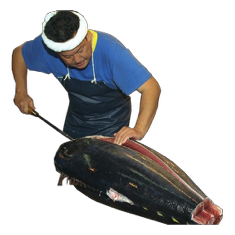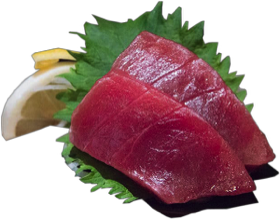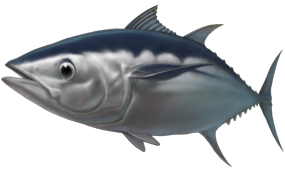BIGEYE TUNA
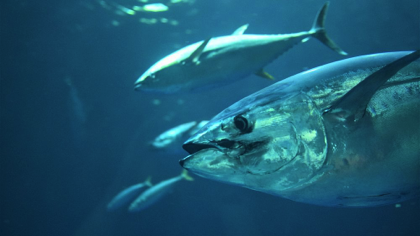
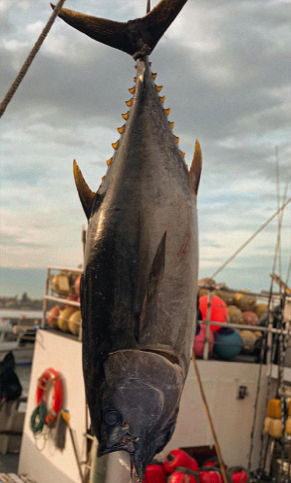
BIGEYE TUNA (Thunnus obesus)
Scientific Name: Thunnus obesus
Market Name: Tuna
Common Name: Bigeye tuna
Description
The Bigeye tuna is a large, fast-swimming species with a metallic-coloured, streamlined body. They are large, deep-bodied, streamlined fish with large heads and eyes. This species is dark metallic blue on the back and upper sides with white lower sides and belly. The first dorsal fin is deep yellow, the second dorsal and anal find are pale yellow, and the finlets are bright yellow with black edges. Live fish have an iridescent blue lateral band running along the sides. The eye is relatively large compared with that of other tunas.
Bigeye tuna can grow up to 250 centimetres or 8 feet, in length. Maximum weight of individuals probably exceeds 180 kg.
Distribution
This species feeds at night and during the day on fishes, squid, and crustaceans found from the surface to a depth of 500 feet, favouring shrimp, Mackerel and other small tuna.
Bigeye tuna (or bigeye) are oceanic fish present throughout Australian waters. Geographic distribution is limited by temperature and oxygen concentrations. They have a greater tolerance to lower temperature and oxygen levels than other tunas, therefore, they tend to occupy deeper waters. They are generally found in more southern waters of Australia's east and west coasts, preferring offshore areas
Physiology
Bigeye tuna have a unique physiology which allows them to forage in deeper colder waters and tolerate oxygen-poor waters. Bigeye tuna are reported to tolerate ambient oxygen levels of 1.0 mL/L and routinely reach depths where ambient oxygen content is below 1.5 mL/L, largely due to the presence of blood with a high oxygen affinity. Vascular counter-current heat exchangers maintain body temperatures above ambient water temperature.
Physiology cont.....
These heat exchangers are engaged to conserve heat in deeper colder waters and are disengaged to allow rapid warming as the tuna ascend from cold water into warmer surface waters, providing short-latency, physiological thermoregulation.
The eyes of bigeye tuna are well developed and with a large spherical lens allowing their vision to function well in low light conditions.
Vertical movement
Bigeye tuna undertake a distinct shift in vertical behaviour, generally descending at dawn to deeper, cooler waters and returning to shallower, warmer waters at dusk. During the day they can undertake vertical movements into waters of 300–500 m depth that can be as much as 20 °C cooler than surface waters. Individuals undertake thermoregulatory behaviour whilst at depth, periodically returning from deeper, cooler waters to shallower, warmer waters to re-warm. Across the Pacific Ocean the depths at which bigeye tuna spend the majority of their time during the day vary: in the eastern Pacific the majority of time is spent at 200–350 m; around Hawaii the majority of time is spent at 300–400 m and in the Coral Sea the majority of time is spent at 300–500 m. These suggest that bigeye tuna (or their prey) are tracking an optimum temperature (10-15 °C) which is shallower in the eastern Pacific Ocean than in the western Pacific Ocean. The shift in the vertical behaviour of bigeye tuna has been suggested to be associated with the migration of their prey. This is supported by the identification of a number of diurnally migrating species from the stomachs of bigeye tuna and observations of close associations between bigeye tuna and the sound scattering layer both during the day and at night.
Life History and Habitat
Bigeye tuna may live longer than 9 years. They may spawn throughout the year in schools, with females laying from 2.9 million to more than 6 million ova.
Bigeye tuna reach reproductive maturity around age 3 at about 3 to 3.3 feet in length. They are serial spawners, capable of spawning almost daily with millions of eggs per spawning event. Eggs are epipelagic (found in the top layer of the ocean). They are buoyed at the surface by a single oil droplet until they hatch.
They spawning throughout the year in tropical waters and seasonally at higher latitudes at water temperatures above 73° F mainly in tropical waters at or near the surface.
Results from tagging studies show that bigeye tuna are capable of traversing ocean basins, but can also show a high degree of site fidelity to some regions. One study suggested an annual migration influenced by water temperature, specifically that near the surface. The fish also briefly travel outside these thermal ranges.
Size
Bigeye tuna can reach a maximum size of 2.36 metres and 210 kg in weight, however it is rare for these tuna to exceed 1.80 metres in length and 150 kg in Australian waters.
Product Profile:
Although yellowfin is more familiar to most people, sushi chefs tend to prefer bigeye for its quality of flavour and slightly higher fat content.
Taste/Texture Bigeye tuna has a mild, meaty flavour, with a higher fat content than yellowfin. It is preferred by sashimi lovers. Because of its high fat content, Bigeye is especially prized as a raw product and is marketed by Pelamis as “sashimi-grade,” with the freshest and fattiest, going to the Japanese market. Bigeye is the darkest and fattiest of any tuna, and its uncooked meat is red.
Nutrition Facts:
Calories: 144
Fat Calories: 44
Total Fat: 4.9 g
Saturated Fat: 1.3 g
Cholesterol: 38 mg
Sodium: 39 mg
Protein: 23.3 g
Omega 3: 1.3 g
PELAMIS BIGEYE TUNA FRESH FROM THE SEA - SNAP FROZEN (-60'C) TO KNIFE TO TABLE
